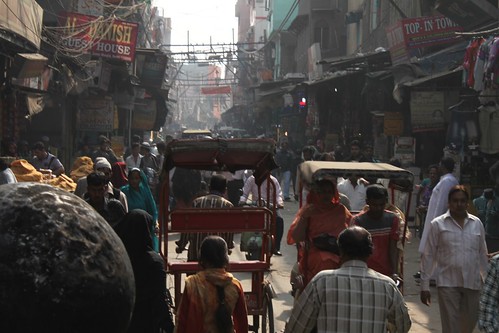
![]() photo credit: Barry & PK
photo credit: Barry & PK
As an Urban Planner working for the last 5 years in small and big cities I have understood one thing that in order to reclaim the aura of Indian cities that existed in past, it is pertinent to focus on sustainability in energy usage, transportation and city administration while implementing any new policies. So, my big idea for cities in 2012 is encouraging urban sustainability in policy measures that would help in improving the plight of our cities.
Lately we have seen a sudden upsurge of new cities encouraging new urbanism and sustainability but while building new cities we should not forget our close to 3,500 cities that requires immediate attention. In this post I would specifically mention those cities that already exist and require strong policy measures for sustainable development and its successful implementation.
Sustainability is not a recent fad in India; infact sustainability in city planning started early- almost 4,500 years back, with the Indus valley Civilisation. The cities of Mohen jo Daro and Harappa were amongst the world’s earliest and most unique examples of urban design but unfortunately in modern India, development in towns and cities has somehow not kept pace with the sustainability measures.
With globalization and increasing job opportunities in metropolitan as well as tier II and III cities, people from villages and small cities are tempted to migrate for better standard of living. Since, core areas in existing cities are already congested with no space for proposed housing, development authorities and private developers are building housing in suburban areas that is leading to problems related to pollution and congestion from private vehicles commuting to core areas for work. Without adequate transportation facilities such as BRTS (Bus Rapid Transit System) and TOD’s (Transit Oriented Development) people rely on their private vehicles for transportation that can have significant impact on the city’s environment. Vehicles account for between 20% and 25% of the world’s energy consumption and carbon dioxide emissions. Therefore, while expanding our city limits to accommodate more people it is important to encourage sustainability in commuting systems by introducing BRTS, local rail system, pedestrian friendly walking, cycling, transit oriented development.
Energy usage in a sustainable manner is another focus area that can help in building sustainable cities. With depleting water and power resources it is important to encourage renewable power sources such as solar energy and wind energy to meet power requirements in residential and commercial buildings. In India many states have started giving incentives for developers promoting these technologies in their projects. Besides that, encouraging rainwater harvesting and efficient storm water management network also leads to sustainable development in cities.
In order to achieve all the above stated objectives, it is important for Urban Local Bodies (ULBs’) to strengthen their financial position by improving their efficiencies in order to ensure sustainability of infrastructure investments. A strong and efficient ULB demonstrate its sustainability by providing its plan for supporting reforms that it proposes to undertake. For example, the ULB’s proposal for levy and enhancement of user charges and taxes, any other sources of revenue identified to make the project viable (eg. tolls, development cess, parking and advertisement fees, betterment levy, etc.)
While planning for an Urban Sustainable city, it is critical to analyse proper urban planning and urban sustainability while proposing any new policy for development. The success of the urban sustainability depends mainly on efficient ULB’s and inclusive development with appropriate funding mechanism in place. A joint effort by the governments, civil society and the private sector and an impartial political interest with a national vision only can save the urban centres of India from the challenges associated with climate change and population impact.
What is your one big idea for cities in 2012? Submit a blog post to info@theurbanvision.com along with a bio & Pic.
